#gamenarrative
Explore tagged Tumblr posts
Text
AI Tools for Gaming
Part of an article I wrote over on my main blog.

AI Game Development Station: A futuristic workspace where cutting-edge AI development meets gaming innovation. This scene captures the essence of using AI tools for game design, with tech-savvy developers collaborating with advanced systems. The glowing screens, futuristic holograms, and cyberpunk aesthetic evoke a sense of possibility in the world of game development. This is where AI agents like MagickML and GPT Pilot come to life to create dynamic narratives and powerful game mechanics.

AI Developer with Pink Hair: A powerful, tech-forward moment captured in this dynamic scene. A developer interacts with advanced AI systems in a visually stunning, neon-lit environment. The glowing colors and futuristic atmosphere set the stage for AI-driven game creation, where tools like Devyan and GPT Pilot automate coding tasks and streamline development pipelines for indie developers. It’s a world where creativity and technology converge seamlessly.

Developer with Multiscreen Setup: An immersive tech workspace featuring multiple screens filled with lines of code, representing the magic behind AI game development. This scene embodies the busy, innovative world where AI agents work together, refining game logic, automating tasks, and designing interactive elements for the next big indie game hit. Tools like Devyan and GPT Pilot enhance productivity, ensuring that indie game developers can focus on storytelling and gameplay.

AI Conversation Tree: A visual representation of an AI-driven conversation system, as used in game development. AI agents, like Charisma AI, create dynamic, branching dialogues that bring NPCs to life in unique and engaging ways. This illustration evokes the endless possibilities in game narrative design, where AI helps build meaningful player interactions and complex character arcs, creating worlds where every choice counts.

Peaceful Stream and Natural Landscape: A serene landscape showcasing the balance between nature and the digital world of game design. This peaceful stream mirrors the calm, methodical process of using AI tools like Scenario and Meshy AI to generate lifelike 3D environments and assets. Developers can harness AI to create lush, detailed landscapes that immerse players in natural beauty and cutting-edge graphics, while ensuring the smooth flow of game development.

Developer in Multiscreen Tech Environment: A glimpse into the world of game development where AI tools are integrated into every aspect of creation. With a focus on coding, AI agents such as GPT Pilot and SWE-agent work behind the scenes, automating bug fixes and generating code for complex game mechanics. This image encapsulates the high-tech, fast-paced environment of AI-driven game creation, where developers bring their digital worlds to life faster and more efficiently.

Game Character with Bright Colors: An electrifying moment featuring a game character brought to life with vibrant colors, embodying the possibilities of AI in character creation. AI platforms like MagickML allow for the creation of unique NPCs with their own personalities, backgrounds, and interactive abilities. These characters evolve dynamically, responding to player choices and narrative shifts. This image captures the fusion of creative design and AI technology in modern game development.

White-Haired Woman in a Cyberpunk World: An intriguing character design set against a glowing, neon-lit world where AI-driven narratives unfold. AI tools like Charisma AI enable developers to craft compelling characters, while agents like Promethean AI create immersive worlds. This image represents the future of AI in game design, where characters are more than just pixels—they are living, evolving entities shaped by AI to offer players rich, interactive experiences.
#AIinGameDesign#GameDevelopment#FuturisticTech#CyberpunkAesthetic#AIpowered#GameNarrative#DigitalArt#AICharacterCreation#GameDevLife#TechArt#VirtualWorlds#IndieGameDevelopment#GameDesignTools#AIArt#FutureGaming
0 notes
Text
Games for Narrative Inspiration
1. For Environmental Storytelling: Dark Souls, Hollow Knight, Inside
2. For Branching Narratives: Disco Elysium, The Walking Dead, Detroit: Become Human
3. For Player-Driven Stories: The Outer Wilds, Skyrim, Baldur’s Gate 3
4. For Emotional Impact: The Last of Us, What Remains of Edith Finch, To the Moon
5. For Experimental Narratives: Her Story, Return of the Obra Dinn, Heaven’s Vault
0 notes
Text
A Love Letter from DJ Wet CupCake to the Citizens of Stormwind, Dorgolo, Dalaran, and Beyond
A Love Letter from DJ Wet CupCake to the Citizens of Stormwind, Dorgolo, Dalaran, and Beyond Hey, my beautiful, magical, and downright legendary fans of Stormwind, Dorgolo, Dalaran, and of course, my dearest Goldshire Lions’ Pride Inn enjoyers. https://kake-moonguard.egirl4rent.com (you know who you are)! First off, let me just say… I LOVE YOU ALL TO THE STARS & BACK! Like, seriously. If I…
#audiovibes#crossgenre#digitalentertainment#digitalmusic#DJnarration#DJWetCupCake#EatMyCakeRecords#eGirl4Rent#electronicbeats#epicbeats#gameimmersive#gamelivestream#gamemusic#gamermusic#gamingsoundtrack#immersiveaudio#in-gameDJ#in-gamenarration#interactiveDJ#liveDJ#livestreamingmusic#MicrosoftZira#MoonGuard#musiccommunity#musicinnovation#musicnarration#musicstreaming#roleplaymusic#spacebeats#spacecountrytrap
1 note
·
View note
Text
Gendernarrator
[PT: Gendernarrator]

[ID: A rectangular flag with 7 stripes. The middle stripe is comparatively thinner than others. The colors from the top to bottom are: donkey brown, pale taupe, pale brown, brown tumbleweed, pale brown, pale taupe, donkey brown. In the middle of the flag is a symmetrical open book symbol. The open pages are pale silver and have same 4 light brown lines on each page immitating writing. The rest of the book ashy brown and is outlined in light brown. End ID.]
Gendernarrator: A gender system in which you are a narrator of [x]; your gender is a narrator of [x]; your gender feels like narrating [x]; you are part of [x] narrative; your gender is a [x] narrative; etc. Example of that could be: girlnarrator, boynarrator, fantasynarrator, gamenarrator or any other alignment that one feels fit this definition. While gendernarrator is a gender system it can also be used as a standalone gender in which one's gender is being a narrator or the gender itself is narrated or is part of the narrative.

[ID: A thin purple line divider shaded at the bottom. End ID.]
@radiomogai
#gendernarrator#gender system#gender coining#mogai coining#mogai term#mogai blog#mogai#liom#liom coining#liom term#mod domijoyce
20 notes
·
View notes
Text

🎮 Obsessed: just dropped on Xbox GamePass. It plays like the Matrix, looks like a comic book, sounds like A Clockwork Orange and vibes like a skate-or-die Hunger Games! #Gaming #Rollerdrome #GameNarrative #Dystopian #GamePass #SkateOrDie @rollerdrome
3 notes
·
View notes
Text

Need For Speed: Deluxe Edition (2015)
Meine Car Setups (01)
Setup des Subaru BRZ (Grip)
Die Einstellungen habe ich zu einer Gesamtliste zusammengestellt. Sie kann als Orientierung und Anregung dienen. Um auch für starke Kurven geeignet zu sein, hat dieses Setup auch leichte Driftakzente, aber die Grip Fähigkeit dominiert hier. Das Feintuning ist aber sicherlich sehr variabel. Den Subaru BRZ kann man freilich auch auf "Drift" optimieren. Sicherlich ist er ein guter und schicker Einstiegswagen.
[Übrigens: in meinem Beitrag vom 10.07.2024 habe ich eine Tabelle mit meinen Car Setups gezeigt. Die Werte habe ich aber am 12.07.2024 z.T. verändert, weiter überarbeitet und versuchsweise etwas optimiert]
Zudem füge ich unten Screenshot Samples dieses Wagens aus "Ventura Bay" bei, der in der virtuellen Welt des Games in Szene gesetzt ist.
[Tipp: auf das Bild klicken, Tumblr bietet keinen Zoom für Bilder; rechten Mausklick und den Screenshot herunterladen; dann kann man etwas vergrößern und die Werte gut lesen]

Mein Forschungsinteresse
Beiträge zur Geschichte des Computerspiels am Beispiel der seit 1995 bestehenden umfangreichen Rennspielserie "Need For Speed". Im Fokus: Wandel der Bildästhetik, Gamenarration, Balancing, Innovation uvm.
Von 2018-2021 habe ich selbst ein paar Computerspiele entwickelt (3D Welten mit bescheidenen Rollenspielelementen). Verwendung: Unity Game Engine, C# Programmierung, Blender 3D. Dies hat mir einen praxisrelevanten Einblick in die Arbeit der Gameentwickler gegeben und meine Analysekriterien entsprechend erweitert.
Im Moment hole ich, nach ca. 10 Jahren Need For Speed "Pause" (zuletzt: NFS Rivals), einige mir noch unbekannter Titel mit Test und Rezensionen nach. Auf der Agenda stehen, wenn mir der Abschluß dieses Games (NFS Deluxe Edition 2015; derzeit 77%) gelingt, NFS Payback und NFS Heat als nahezu letzte mir unbekannte Serientitel noch bevor (bereits über Steam installiert). NFS Unbound (EA 2022) hatte ich vor einigen Wochen bereits getestet und diverse Beiträge in meinen Social Media Kanälen hochgeladen.
[NFS World wäre mir auch noch unbekannt, dieses Game kann ich aber zu Testzwecken leider nicht mehr erwerben.]
Dr. Andreas Korn, 12.07.2024
+ + +
0 notes
Text
AX3002- Bible Research “The art of Spiderman into the Spider verse“
Next as part of my bible research I looked into the “The art of the Spiderman into the Spiderverse” while this isn’t a game bible and is instead a film I thought it would be worth doing a look into considering that I own the book along with the previous two and it will give me an insight to how a films bible is done.
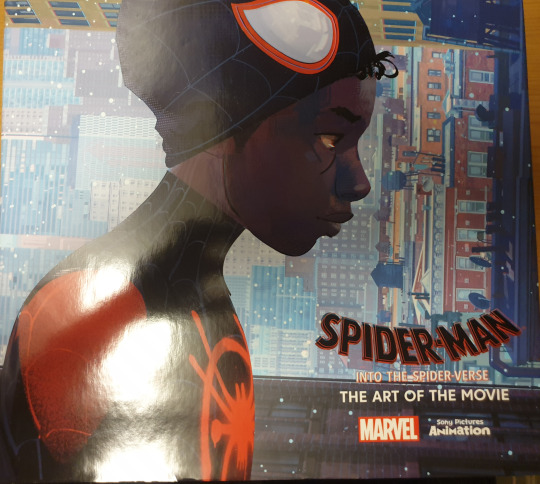

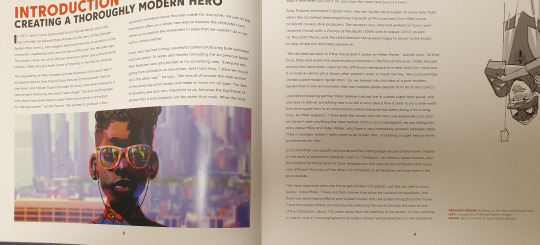

Again the first thing I focused on was how the book starts with its contents page and introduction with the concepts page using a large full page illustration of the main character. The introduction to this book however used alot more writting than the previous two I had looked into expain the thoughts and goals of the film. The next page talks more about the visual style as the film used a new style of animation which hadn’t been done before.

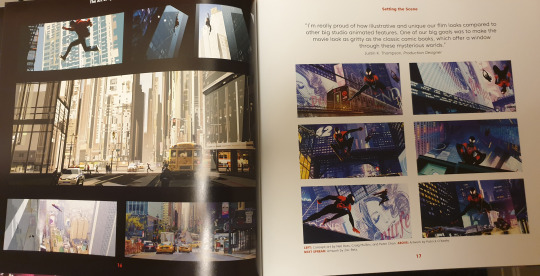
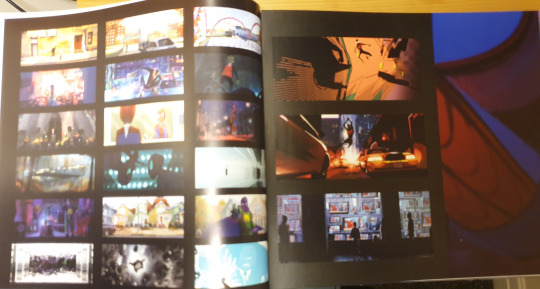
The next thing that comes after the introduction is more illustations showint the enviroments of the film but also attempts to esablish the tone of the film but looking at these illustrations you get a clear sence of the world and the characters.
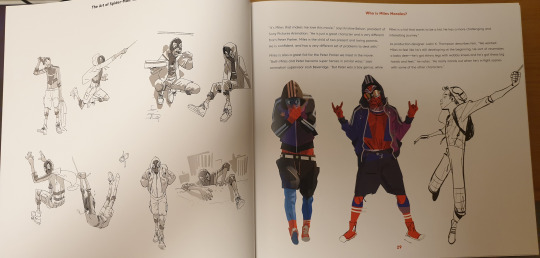

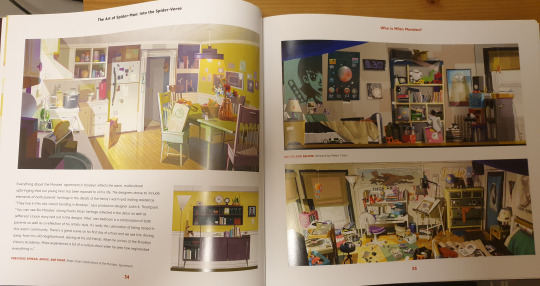
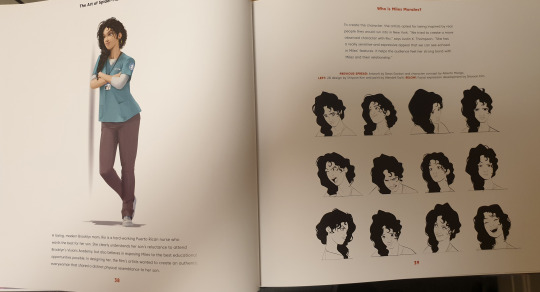






This book did use a different layout to the previous books which would split it to characters then enviroments this book shows the character using a final render front and back with some concepts as well as a full mood board for most characters and well as some other poses of the character showing off their personality. The book presents its enviroments with the characters it relates to like Mile’s house after showing Miles and his family and the facility in the film before showing the page for Gwen.
This book did suprisingly give me some ideas for how I could present some pages of my book as I like the idea of enviroments being presented with the character they belong to though I would have to make some time to do those drawings if I wanted to present it like that.
2 notes
·
View notes
Photo

Manifesto for what a game is, a discussion I made as part of my game narrative paper.
1 note
·
View note
Photo

SOON! My talk is coming up, Vitality of Visual Storytelling in Games 😍 #gamedev #gamenarrative #interactive #storytelling #stories #art #gameart #lovemyjob #pgclondon (at London, United Kingdom) https://www.instagram.com/p/Bs7wfuxhxRc/?utm_source=ig_tumblr_share&igshid=1q55d0jwaiavz
0 notes
Photo

This looks more like SIDE MISSIONS. “Geralt, Ciri needs your help.” “Excuse me, Geralt. Could you defeat this monster first?” “Geralt, I need some rare herbs.” #videogames #storytelling #gamenarratives #thenarrative #funnybecauseitstrue https://www.instagram.com/p/Bt_vMyoAFyZ/?utm_source=ig_tumblr_share&igshid=1oekcid1nbtlx
0 notes
Text
The Gardens Between's Narrative Designer Reveals How Games Get Their Stories #gamedesign #gamenarrative #gamedev http://buff.ly/2p0poX0
The Gardens Between's Narrative Designer Reveals How Games Get Their Stories #gamedesign #gamenarrative #gamedev http://buff.ly/2p0poX0 via http://buff.ly/2p0poX0
0 notes
Text
Is narrative important in games?
Certain genres, such as adventure games and their various sub-genres, have narrative as an essential element, while others, such as real-time strategy, do not require detailed stories as a feature. Some games feature a "story mode" (sometimes also called "narrative mode"), a mode that is designed to focus on the story.
A video game's narrative is important because it helps the player feel more involved and more immersed in the game. It gives everything in the game meaning and helps the player understand what they need to do. The advantage of video games is that, unlike with other types of narrative, the player is part of the story.
0 notes
Text
Non-linear narrative issues. The four narrative topologies.
In the previous entry I've established a few definitions and mentioned the narrative topologies as ready-made solutions for writers/game-designers. This time I will discuss them at length weigh pros and con's.
Trigger warning: unpopular opinions on AAA and cult games. It's just, like, my opinion, man. If I am wrong about anything but punctuation and trying to write this blog, please let me know. I am writing this to understand and explain what I think I know.
Allow me to start with a quiz! Image you're a writer/game designer and you have a vague concept in your head you don't know what to do with. Answer these 4 questions: 1. Do I want to tell my story? 2. Do I want to design an exciting game to just fool around in? 3. Can I dedicate to it tons of effort and work hours? 4. Do I want each and everyone to experience the game differently? 5. Do I want the story to be nothing but a premise?
Now check your answers: Linear: 1Y, 2N, 3Y, 4N, 5N Modular: 1Y 2Y 3N 4Y, 5N Branching: 1-4Y, 5N Emergent: 1N, 2Y, 3Y, 4Y, 5Y
Well, I didn't quite think this through. But now that you get as vague picture as is your concept, you, probably, would like some explanations.
You see, these four topologies represent the evolution in game development industry's view on storytelling in games. Initially, the game's story was nothing but a premise, usually physically left out of the game and printed in the manual and never mentioned again. Later the game developers tried to incorporate story into their games and thus appeared dialogue and cut-scenes, both non-interactive and fed in between the levels. Then some bright minds decided that they want to let the gamer play with the story. Arguably, this is caused by influence from tabletop role-playing games and gave way for Modular and Branching topologies. But some developers that loved modelling situations systems ,particularly, Sid Meier and Will Wright created games in which the player's actions created a story that they loved to share with each other.
For this article I've dropped the game's space concept. It is stupid to draw it for the whole narrative topology because whatever the narrative is, there might be multiple side-missions with their own plots and fail/win states. I can draw it for Max Payne as a line with few peaks, but for GTA int would be a really nuanced space.
So the 4 narrative topologies are (in order of increase in player's influence on the story): 1. Linear - what you use when you have a movie, a story in your head but want to let the people play around a bit. Also you want everyone to experience the story just the way you intended to. 2. Modular - what you use when you want to give the player an illusion of influence and role-playing. At least he chooses to be cartoonishly evil or as kind as a sedated person. 3. Branching - what you use when you want to let the player experience the story and gameplay from few different perspectives and give the player limited but real choice and influence over the world. 4. Emergent - what happens when you concentrate on game and overall world design and let the story be just a premise for whatever the gamer's doing in the game. The script becomes whatever the player feels like doing.
Now I will clarify.
Linear

It's a go-to for a frustrated filmmaker who didn't get his funding for a real movie and for a writer/game designer who wants to make people feel more involved with his/her story. It may be as pure and clear as "Max Payne" or as obscured with cosmetic choices and well-designed gameplay that allows some emergence as "Grand Theft Auto" series is. Because no matter what you say, the latter is entirely linear with some branches that get no closure whatsoever and design that creates a clever illusion of non-linearity.
+ everyone experiences the story and game exactly as you intended; + it's a cheaper vent for your inner cinematographer's/storyteller's ambitions in a more welcoming market, I mean, the market that can take more awkward stories and pacing; + a good story and game design interaction here automatically results in flow.
- when your story's mediocre and filled with plot holes, the gameplay can't hide it. Works both ways: when the gameplay isn't right, your story can't hide it; - everyone thinks he would make better choices in game's circumstances, so you must make some extra justification for characters' actions.
Modular
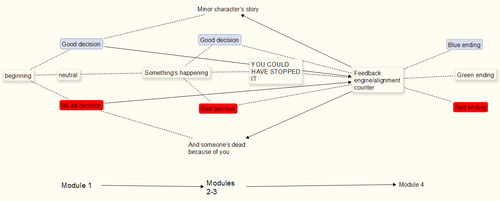
Above you see a Mass Effect/Wolf Among Us binary moral decision model. It's a go-to for action/rpg the likes of "Mass Effect" and interactive movies a-la "Wolf Among Us" and "Heavy Rain". The script can be broken into few key events, as I call them, modules. There is some feedback from your decisions which means usually very little for plot advancement and your decisions influence the outcome.
+ it's an excellent way to tell a linear story whilst making people feel they have influence on the script or play themselves; + as a concept, it's genius for it looks like a non-linear with minimal effort; + you can tell everyone's story and make it optional; + it usually rewards replays for the player might not collect everything in a single run; + a good story and game design interaction automatically results in flow.
- it's very hard to give all the plot lines a proper closure, which was the main cause for anger over "Mass Effect" trilogy's ending; - the script remains the same and doesn't branch substantially, so the player's influence on the script may be considered cosmetical as choice consequences happen to minor characters and the sequence of modules is always the same.
Branching

Branching narrative topology offers the player a fairly limited, but a real choice in the script. The player gets to look at events from different points of view and play different quests, sometimes, in a single run. It is prominent in "Gothic" series and, obviously, in "The Witcher 2". The endings may vary as in "Witcher 2" and "Gothic 3" or they might split at one point and lead to a single outcome which is never a choice as in "Gothic 1-2" and all "Risen" games.
+ different perspectives encourage replayability; + limited yet actual choice; + there are N branches of different gameplay where you must create the flow for the gamer, but it is constant and strong if you resist from making spikes in difficulty.
- the journey is usually better than destination, the ending is anticlimactic due to the need to be satisfying for all the branches; - there can be too much branching so, whatever your ambitions are, please consider that each branch requires being logically sound and thoroughly polished.
Emergent

As you can see, the emergent narrative is less like a plan and is an actual complex system. As in any game we have a set of rules which determine our progress, available interactions and world's structure and behavior. But all the parts of a system shown above interact with each other and are mechanics that create dynamics.
Mechanics are the formal rules of the game. The agents, objects, elements and their relationships in the game. They define the game as a rule-based system, specifying what there is, how everything behaves, and how the player can interact with the game's world.
Dynamics are the emergent behavior that arises from gameplay, when the Mechanics are put into use.
Aesthetics are what makes a person emotionally attracted to or involved with the game.
But don't take my word for it, read about Mechanics-Dynamics-Aesthetics it in the official MDA paper.
+ the game involves the player emotionally with itself; + the player can express himself in the game; + the player can play out his own story and it will be unique; + an absolute game in Johan Huizinga's terms; + the flow is also emergent but very fragile.
.- it's not really easy to tell any kind of story is such a game and it is likely to be seen as a distraction if aesthetics does not rely on it; - it is very hard to design and requires a lot of talent; - it also requires loads of testing to see how everything works
In conclusion, I must tell you that no matter what narrative topology you choose, there are some places where you can't spare any effort or quality:
the narrative must be logically sound either generally or, at least, in game's world;
the choices per one situation must equal, balanced, logical and clear, e.g. you cannot describe a dialogue choice on the screen as "Hello!" if it results in your protagonist quoting the Hamlet's monologue or punching others with a sledgehammer, at least if it doesn't make sense in the game's world;
the consequences of an offered choice must vary.
Follow these if you never want to frustrate your player ever. But if frustration is a part of experience we will have a completely different conversation.
1 note
·
View note
Text
Mundane Narratives
When it comes to game narratives, I’m really interested in micro-stories - those which are focused on something small, sometimes even mundane. I’m not sure why - maybe (ok, definitely) I’m fatigued by both game and film industries that seem obsessed with continually one-upping the epicness - but that’s another story.
What are some examples?
Although it’s nearly 10 years old Facade is one title that I still enjoy, and I recommend checking it out if you haven’t. I’m interested in how games can use nuanced social situations as a mechanic. Making a personal connection with an NPC seems like a really nice, natural reward, whether you gain some kind of explicit advantage (such as a piece of heart), or simply break down some of the character’s emotional walls and gain an insight into their personal life (an idea I wanted to play with more in With The Dust).
A more recent experience of this was Hatoful Boyfriend (I really recommend this game <3). A large number of the story branches are about performing simple acts of kindness or expressing sympathy with a character, with the sole reward of learning about their personality and uncovering their story.
It would be fun to apply this to different scenarios, probably resulting in something ludicrous. I mean, what would happen if you applied the Facade idea to a last-people-on-Earth scenario? Like, you’re stuck round a campfire trying to survive with a few people who really get on your tits? Or you’re having a really awkward conversation where you have to try to address the elephant in the room - the sensitive matter of re-populating the planet?
It would also be great to try this idea out in VR - with voice recognition and even a simple dialogue engine, something like Facade could be quite entertaining.
0 notes
Text
Customizing my own Mandalorian avatar sounds amazing, but I don’t need a #Mandalorian game to be open world. A modern version the Jango Fett singe-player #BountyHunter game is A-OK! #VideoGames #StarWars #GameMechanic #GameNarrative
1 note
·
View note